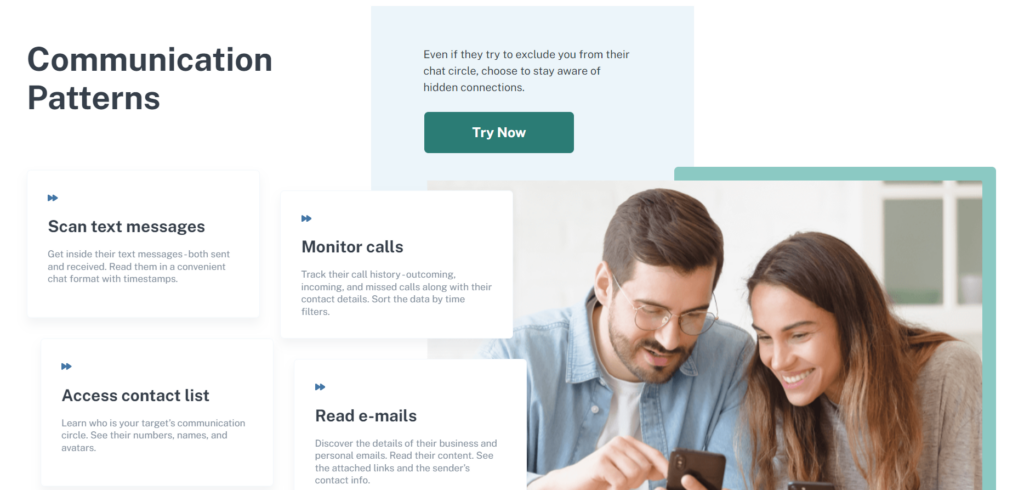Do you want to keep an eye on your employee’s Email activities, as you think there might be some illegal activities going on? Or are you curious about your child’s or your partner’s Email activities and want to know with whom they are connected and what they are dealing with?
If this is the situation, you must be looking to learn how to hack someone’s Email. Well, getting into someone’s Email activities is a difficult job, but don’t worry, as we are here to help you.
In this guide, we will discuss the four methods to hack someone’s Emailwithout letting them know. At the end of this guide, you will be able to view your loved ones or employees’ Email activities.
So, let’s get started.
Is It Possible to Hack Someone’s Email?
Before getting straight to the methods to view someone’s Email activities, it’s better to first answer the most asked question, ‘Is it really possible to hack someone’s Email?’
Well, hacking someone’s Emailis a difficult but possible job. However, it seems like an unethical job. But there are situations in which you need to view someone’s Email activities in order to keep them or your business safe. That is why, you have to hack their Email.
Now let’s discuss the top four methods of hacking Emails.
Top 4 Methods of Hacking Email
As said above, hacking someone’s Email account is a difficult but possible job.
So, here are the top four methods you can use to get into your parents, children, employees, or partners’ Emails.
Method 1: Guessing Password
The first and the most common method to hack someone’s Email is guessing their password. This method is also referred to as “brute forcing” or “password cracking,” which involves trying to gain access to an account by systematically guessing the password.
This method involves trying commonly used passwords, using personal information about the account holder (like birthdays, pet names, etc.), or using automated software to generate a large number of guesses quickly.
It’s a trial-and-error process that relies on the hope that the account holder has used a weak or easily guessable password.
Pros:
- Simple to Understand: The concept is straightforward and doesn’t require advanced technical knowledge.
- No Special Tools Required: In its most basic form, it can be done manually without any specialized Email hacker software.
- Effective for Weak Passwords: It can sometimes be successful if the account holder uses a very weak or common password.
- Potential Access to Additional Accounts: If successful, the same password might be used by the individual for multiple accounts, providing broader access.
- Cost-Effective: It doesn’t necessarily involve any financial cost (although using advanced cracking tools might).
Cons:
- Time-Consuming: It can take an immense amount of time, especially with the increasing complexity and length of passwords.
- Low Success Rate: With strong passwords and security measures like CAPTCHA, account lockouts, and two-factor authentication, the success rate is extremely low.
- Potential for Triggering Security Alerts: Many systems are designed to detect and alert account holders of suspicious login attempts, potentially alerting the target and triggering security protocols.
Method 2: Use Phonsee
Another and highly recommended method to get into someone’s Emails is Phonsee.

This method involves installing a type of surveillance or monitoring software called Phonsee, which is designed to track and log activities on a device that might include Email access.
These types of apps are often marketed as solutions for parental control or employee monitoring, providing a dashboard that displays the activities on the monitored device, including Email interactions, messages, and even location data.
So, by using Phonsee, you will be able to view someone’s Email activities, including their sent and received Emails, pictures, files, etc.
Pros:
- Comprehensive Monitoring: Provides a detailed overview of device activities, not limited to just Emails.
- Stealth Operation: It operates invisibly on the target device, without the user’s knowledge.
- Remote Access: Allows monitoring from a remote location, providing convenience and continuous access.
- User-Friendly Interface: It typically comes with an easy-to-use dashboard for viewing collected data.
- Control Features: May offer additional control features like blocking websites or restricting app usage.
- Alerts and Notifications: Can provide real-time alerts on specific activities.
Cons:
- Cost: Quality monitoring software typically comes with a subscription fee.
- Technical Challenges: Installation and maintenance of this software may require some technical knowledge and can encounter compatibility issues with certain devices or operating systems.
Method 3: Phishing
The most common method to hack anyone’s Email account is Phishing.
This method involves tricking someone into revealing their personal information, such as passwords or other important details, by pretending to be a trustworthy entity.
Typically, this is done by sending an Email that looks like it’s from a legitimate company, like a bank or social media platform, and asking the recipient to enter their Email credentials on a fake website that mimics the real one.
The hacker then captures the entered information to log in to the target’s Email account and see everything.
This method has a high success rate as people don’t pay attention to the legitimacy of a website where they are putting credentials. However, it’s a really difficult job to use this method as it requires technical skills.
Pros:
- Effective Against Unsuspecting Targets: Can be successful if the target is not aware of such scams.
- No Direct Hacking Required: Doesn’t require breaking into an Email server or system directly.
- Wide Reach: A single phishing attempt can target many individuals at once.
- Cost-Effective: Relatively low-cost method compared to other hacking techniques.
- Customizable: Phishing Emails and web pages can be tailored to closely mimic legitimate communications, increasing the chance of success.
Cons:
- Risk of Being Caught and Prosecuted: Law enforcement agencies actively pursue phishing scams, and getting caught carries severe penalties.
- Requires Skill to Execute Convincingly: Crafting convincing phishing Emails and fake websites requires skill and knowledge.
- Damage to Reputation: If associated with a phishing scam, it can lead to irreparable damage to your reputation or business.
Method 4: Use Smartphone Monitoring Apps
The final method to hack someone’s Email is to use smartphone monitoring apps. These apps are not hacking software but monitoring tools that can help you keep an eye on your target’s Email activities.
Some of the smartphone monitoring apps are:
- mSpy
- FlexiSPY
- Norton Family
- Cocospy
- Spyzie
- Qustodio
- Highster Mobile
This method involves the installation of these apps onto a targeted individual’s smartphone with the primary objective of tracking and comprehensively recording their various digital activities.
These monitoring applications are originally designed for lawful purposes, including parental control to ensure the safety of children online or employee monitoring to enhance productivity in a corporate setting.
So, you will have to use them accordingly.
Pros:
- Comprehensive Monitoring: Provides a wide range of data on the target’s smartphone activities.
- Real-time Access: Allows for real-time monitoring of calls, messages, and more.
- Useful for Parental Control: This can be legitimately used by parents to monitor their child’s online safety.
- Employee Monitoring: Employers can use it to monitor company-owned devices and employee productivity.
- Security: Some apps offer features to help track a lost or stolen device.
Cons:
- Cost: Quality monitoring apps often require a subscription fee.
- Abuse and Misuse: Such apps can be misused for invasive surveillance and stalking.
- Technical Challenges: Installation and maintenance may require technical knowledge and can face compatibility issues with certain devices or operating systems.
So, that’s how to get into someone’s Email. Now let’s discuss how you can protect your Email account from hacking.
How to Protect Your Email Account from Hacking?
Protecting your Email account from hacking is crucial because Email accounts often contain sensitive information and are a gateway to other online accounts.
Here are some tips you can follow to enhance the security of your Email account:
- Use a strong, unique password:
A strong password is the first line of defense for your Email account. Create a password that includes a combination of uppercase and lowercase letters, numbers, and special characters. Avoid easily guessable information like birthdays or common phrases.
- Enable two-factor authentication (2FA):
Two-factor authentication adds an extra layer of security by requiring you to provide a second verification method, typically a one-time code sent to your mobile device, in addition to your password. This ensures that even if someone obtains your password, they won’t be able to access your Email account without the second factor, which you possess.
- Regularly update your password:
Changing your Email password periodically is a proactive step to maintain security. Aim to update it every 3-6 months to reduce the risk of a potential breach.
When changing your password, avoid using previous passwords to ensure that you always have a fresh layer of security in place.
- Be cautious with Email links and attachments:
Cybercriminals often use phishing Emails with malicious links or attachments to gain access to your account. To protect yourself, avoid clicking on links or downloading attachments from unknown or suspicious sources.
Hover over links to see the actual URL before clicking and be vigilant about scrutinizing Emails that seem unusual or ask for sensitive information.
- Protect your recovery options:
Your Email account often has recovery options, like an alternate Email address or phone number. Make sure these are up-to-date, as they are used to regain access to your account if you forget your password.
It’s equally important to use strong, unique passwords for these recovery options to prevent attackers from using them to compromise your account.
- Log out of your Email account on shared devices:
When using a public computer or shared device to access your Email, always log out of your account when you’re finished. This ensures that your session is not left open for someone else to access.
Conclusion
In conclusion, while we have discussed methods related to “how to hack someone’s Email,” it’s important to note that hacking someone’s Email account is unethical.
Instead of resorting to such options, we strongly recommend using legitimate monitoring tools like Phonsee. It is designed for lawful purposes such as parental control or employee monitoring while respecting privacy and consent.

Jeremy White, a seasoned cybersecurity expert, delves deep into the labyrinth of social media vulnerabilities. With a wealth of knowledge and experience, he navigates the intricacies of digital landscapes, uncovering threats and fortifying defenses. Jeremy’s expertise shines in safeguarding against online risks, ensuring digital safety in an interconnected world.


